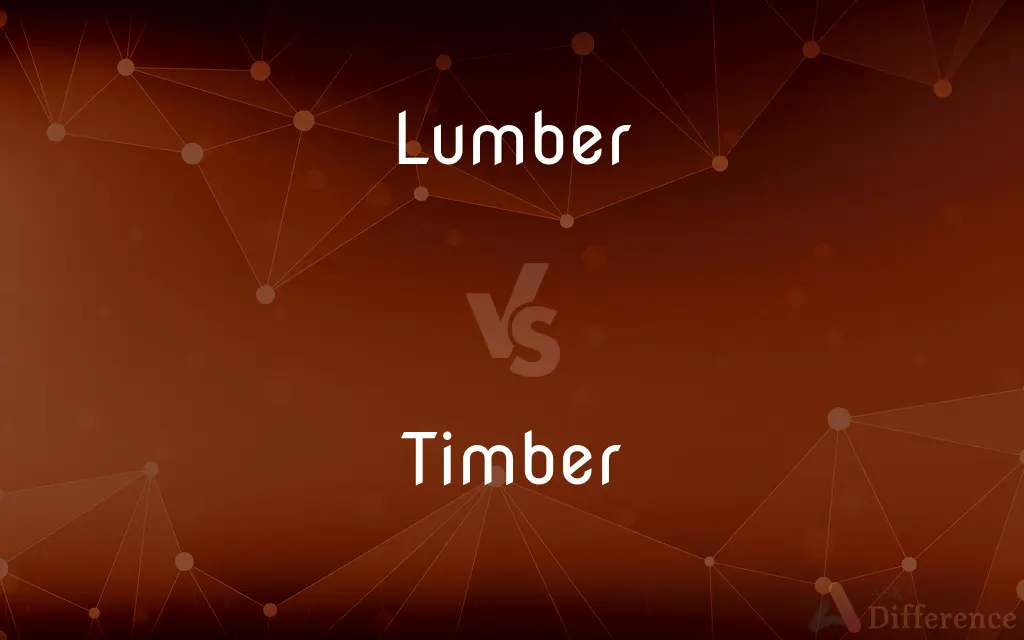Lumber vs. Timber — What's the Difference?
By Maham Liaqat & Urooj Arif — Updated on March 11, 2024
Lumber is a wood that has been processed into beams and planks, a stage in wood production mostly used in the US and Canada. Timber is used in other English-speaking countries for wood that has been cut but not yet processed into finished products.

Difference Between Lumber and Timber
Table of Contents
ADVERTISEMENT
Key Differences
Lumber and timber are terms related to wood but are used differently depending on the geographical location and the stage of wood processing. In North America, lumber is the term used to describe wood that has been processed into beams, planks, or other building materials. It's typically measured in board feet and used in construction. Timber, in this context, refers to trees that are still standing or wood that has been cut but not yet processed into finished products, often used for larger structural pieces or as raw material for further processing.
In other English-speaking countries, such as the UK and Australia, the term "timber" is more commonly used to describe what Americans and Canadians would refer to as lumber. Here, timber can mean both the unprocessed wood from trees and the processed wood used for construction and carpentry. The usage of these terms can sometimes lead to confusion among professionals and laypeople when discussing wood products across different regions.
The characteristics of lumber depend on the type of wood, the part of the tree it comes from, and the way it has been processed. Lumber can be treated or untreated, and its quality is graded based on factors like strength, appearance, and defects. Timber, when referring to unprocessed wood, is valued for its potential to be turned into a variety of wood products, from construction materials to furniture.
Sustainability practices are important in both the harvesting of timber and the production of lumber, with certifications like the Forest Stewardship Council (FSC) ensuring responsible management of forests. The environmental impact of using wood as a resource is a significant consideration, with both lumber and timber playing roles in discussions about deforestation, carbon footprint, and renewable resources.
In construction and carpentry, the choice between using lumber or timber (in the broader sense of processed wood) often depends on the specific requirements of the project, such as structural strength, aesthetic considerations, and cost. The terms may be used interchangeably in casual conversation, but understanding their specific meanings is crucial for accurate communication in professional settings.
ADVERTISEMENT
Comparison Chart
Definition
Wood that has been processed into beams, planks, or other building materials.
Wood in its natural state as trees or as cut logs, and also processed wood in some regions.
Usage
Mainly in construction and carpentry for building homes, furniture, etc.
Used both for unprocessed wood and in construction and carpentry, depending on the region.
Measurement
Typically measured in board feet.
Measured in various units, depending on whether it's processed or unprocessed.
Processing Stage
Processed stage, ready for use in construction and other applications.
Can refer to both unprocessed and processed stages, depending on the context.
Regional Preference
Preferred term in the United States and Canada.
Preferred term in the UK, Australia, and other English-speaking countries outside North America.
Compare with Definitions
Lumber
Processed wood ready for construction.
The carpenter bought lumber to build a new deck.
Timber
Standing trees or cut wood.
The forester assessed the timber for harvest.
Lumber
Measured in board feet for trade.
Lumber prices fluctuate based on market demand.
Timber
Used globally to mean processed wood.
Timber beams support the old barn roof.
Lumber
Essential in building construction.
Lumber is the primary material for framing houses.
Timber
Integral to construction.
Timber framing is a traditional building method.
Lumber
Graded based on quality.
High-grade lumber is used for visible parts of furniture.
Timber
Subject to sustainable practices.
Sustainable timber comes from well-managed forests.
Lumber
Can be treated for durability.
Treated lumber is essential for outdoor structures.
Timber
Versatile in carpentry.
The joiner selected quality timber for the new staircase.
Lumber
Lumber, also known as timber, is wood that has been processed into beams and planks, a stage in the process of wood production. Lumber is mainly used for structural purposes but has many other uses as well.
Timber
Trees or wooded land considered as a source of wood.
Lumber
Timber sawed into boards, planks, or other structural members of standard or specified length.
Timber
Wood used as a building material; lumber.
Lumber
Something useless or cumbersome.
Timber
A dressed piece of wood, especially a beam in a structure.
Lumber
Chiefly British Miscellaneous stored articles.
Timber
(Nautical) A rib in a ship's frame.
Lumber
To cut down (trees) and prepare as marketable timber.
Timber
A person considered to have qualities suited for a particular activity
That trainee is executive timber.
Lumber
To cut down the timber of.
Timber
To support or frame with timbers
Timber a mine shaft.
Lumber
Chiefly British To clutter with or as if with unused articles.
Timber
Used by one cutting down a tree to warn those around that the tree is about to fall.
Lumber
To cut and prepare timber for marketing.
Timber
(uncountable) Trees in a forest regarded as a source of wood.
Collect timber
Cut down timber
Lumber
To walk or move clumsily or heavily.
Timber
Wood that has been pre-cut and is ready for use in construction.
Lumber
To move with a rumbling noise.
Timber
(countable) A heavy wooden beam, generally a whole log that has been squared off and used to provide heavy support for something such as a roof.
The timbers of a ship
Lumber
(North America) Wood sawn into planks or otherwise prepared for sale or use, especially as a building material.
Timber
Material for any structure.
Lumber
Old furniture or other items that take up room, or are stored away.
Timber
The wooden stock of a rifle or shotgun.
Lumber
(figurative) Useless or cumbrous material.
Timber
(archaic) A certain quantity of fur skins (as of martens, ermines, sables, etc.) packed between boards; in some cases forty skins, in others one hundred and twenty. Also timmer, timbre.
Lumber
(obsolete) A pawnbroker's shop, or room for storing articles put in pawn; hence, a pledge, or pawn.
Timber
Used by loggers to warn others that a tree being felled is falling.
Lumber
A baseball bat.
Timber
(transitive) To fit with timbers.
Timbering a roof
Lumber
An erect penis.
Timber
To construct, frame, build.
Lumber
(intransitive) To move clumsily and heavily; to move slowly.
Timber
To light or land on a tree.
Lumber
To load down with things, to fill, to encumber, to impose an unwanted burden on.
They’ve lumbered me with all these suitcases.
I got lumbered with that boring woman all afternoon.
Timber
(obsolete) To make a nest.
Lumber
To heap together in disorder.
Timber
(transitive) To surmount as a timber does.
Lumber
To fill or encumber with lumber.
To lumber up a room
Timber
A certain quantity of fur skins, as of martens, ermines, sables, etc., packed between boards; being in some cases forty skins, in others one hundred and twenty; - called also timmer.
Lumber
A pawnbroker's shop, or room for storing articles put in pawn; hence, a pledge, or pawn.
They put all the little plate they had in the lumber, which is pawning it, till the ships came.
Timber
The crest on a coat of arms.
Lumber
Old or refuse household stuff; things cumbrous, or bulky and useless, or of small value.
Timber
That sort of wood which is proper for buildings or for tools, utensils, furniture, carriages, fences, ships, and the like; - usually said of felled trees, but sometimes of those standing. Cf. Lumber, 3.
And ta'en my fiddle to the gate, . . . And fiddled in the timber!
Lumber
Timber sawed or split into the form of beams, joists, boards, planks, staves, hoops, etc.; esp., that which is smaller than heavy timber.
Timber
The body, stem, or trunk of a tree.
Lumber
To heap together in disorder.
Timber
Fig.: Material for any structure.
Such dispositions are the very errors of human nature; and yet they are the fittest timber to make politics of.
Lumber
To fill or encumber with lumber; as, to lumber up a room.
Timber
A single piece or squared stick of wood intended for building, or already framed; collectively, the larger pieces or sticks of wood, forming the framework of a house, ship, or other structure, in distinction from the covering or boarding.
So they prepared timber . . . to build the house.
Many of the timbers were decayed.
Lumber
To move heavily, as if burdened.
Timber
Woods or forest; wooden land.
Lumber
To make a sound as if moving heavily or clumsily; to rumble.
Timber
A rib, or a curving piece of wood, branching outward from the keel and bending upward in a vertical direction. One timber is composed of several pieces united.
Lumber
To cut logs in the forest, or prepare timber for market.
Timber
To surmount as a timber does.
Lumber
The wood of trees cut and prepared for use as building material
Timber
To furnish with timber; - chiefly used in the past participle.
His bark is stoutly timbered.
Lumber
An implement used in baseball by the batter
Timber
To light on a tree.
Lumber
Move heavily or clumsily;
The heavy man lumbered across the room
Timber
To make a nest.
Lumber
Cut lumber, as in woods and forests
Timber
The wood of trees cut and prepared for use as building material
Timber
A beam made of wood
Timber
A post made of wood
Timber
Land that is covered with trees and shrubs
Timber
(music) the distinctive property of a complex sound (a voice or noise or musical sound);
The timbre of her soprano was rich and lovely
The muffled tones of the broken bell summoned them to meet
Common Curiosities
How is lumber quality graded?
Lumber is graded based on factors like knot size, straightness, and the presence of defects, affecting its strength and appearance.
What's the environmental impact of using lumber and timber?
The impact includes deforestation and carbon emissions, but sustainable forestry practices help mitigate these effects.
Is lumber only used for construction?
Primarily, yes, but lumber is also used in furniture making, flooring, and other woodworking projects.
Why are sustainable practices important in timber production?
Sustainable practices ensure the long-term health of forests, biodiversity, and the availability of wood as a resource.
Can timber refer to processed wood?
Yes, especially outside of North America, timber can refer to both unprocessed and processed wood.
Can the terms lumber and timber be used interchangeably?
In casual conversation, they often are, but professionals use them to refer to specific stages of wood processing.
What factors influence the choice of wood for a project?
Factors include the wood's strength, durability, appearance, cost, and the specific requirements of the project.
How do lumber prices affect the construction industry?
Fluctuations in lumber prices can significantly impact the cost of building projects and housing market prices.
What is board foot measurement?
A board foot is a volume measure of lumber, equal to a piece one foot long, one foot wide, and one inch thick.
How does the choice between lumber and timber affect construction?
It depends on the project requirements, local terminology, and the specific properties needed from the wood.
What's the difference between hardwood and softwood lumber?
Hardwood comes from deciduous trees and is generally denser, used for flooring and furniture, while softwood comes from coniferous trees and is used more in construction.
How do certification programs like FSC contribute to wood sustainability?
They ensure that wood products come from responsibly managed forests, promoting environmental, social, and economic benefits.
Is all lumber treated?
Not all; lumber can be either treated or untreated, depending on its intended use, especially regarding exposure to elements.
What role do forests play in carbon sequestration?
Forests absorb CO2 from the atmosphere, playing a crucial role in mitigating climate change, which is a consideration in sustainable timber harvesting.
Are there alternatives to traditional lumber and timber?
Yes, alternatives include engineered wood products, bamboo, and recycled or reclaimed wood, offering sustainable and sometimes more durable options.
Share Your Discovery

Previous Comparison
Automatic vs. Automated
Next Comparison
Pathology vs. CytologyAuthor Spotlight
Written by
Maham LiaqatCo-written by
Urooj ArifUrooj is a skilled content writer at Ask Difference, known for her exceptional ability to simplify complex topics into engaging and informative content. With a passion for research and a flair for clear, concise writing, she consistently delivers articles that resonate with our diverse audience.
















































